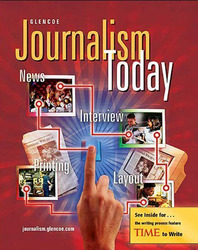
Journalism TodayChapter 19: Understanding Technical Aspects of PhotographyOverviewPhotography is painting with light: the camera is the brush and the film is the canvas. As a photographer, you control what the brush puts on the canvas by manipulating the f-stop and the shutter speed. The f-stop is the setting on the lens that indicates the aperture, or lens opening in numbers. Larger f-stops (such as f/2 and f/1.4) allow more light to reach the film. Smaller f-stops (such as f/16 and f/22) allow less light to reach the film. Consecutive f-stops let in either twice as much light or half as much light as their neighbors. If the subject reflects bright light, a smaller aperture is used. If the subject reflects little light (if it's dark), a larger aperture is used. Too much light can result in an overexposed image (in which the lighter parts of the scene become too light), and too little light can result in an underexposed image (in which the darker parts of the scene become too dark). The f-stop also controls the depth of field, the area of the total picture in front of and behind the subject that appears in sharp focus. With smaller apertures, more of the total picture appears in sharp focus; with larger apertures, less of the picture appears in sharp focus. While the f-stop controls the amount of light reaching the film, the shutter speed controls the length of time that the film is exposed to that light. The shutter is the part of the camera that moves or is released to allow light to reach the light-sensitive surface of the film. The shutter remains open for a very specific duration of time; the longer that time the more light can reach the film. For example, a shutter speed of 1/60th of a second allows twice as much light to reach the film as a speed of 1/125th of a second. Shutter speeds are measured in multiples of two and are expressed without the fraction. For example, 60 indicates 1/60th of a second. Like f-stops, each adjacent shutter speed lets in either twice as much or half as much light as its neighbor. The shutter speed also impacts what is in focus. To avoid blur, the slowest shutter speed that can be used with a given lens is approximately equal to the focal length of that lens. For example, use the 60 setting for a 50mm lens. Longer shutter speeds require the use of a stabilizing device, like a tripod. Stop-action photography requires fast shutter speeds, between 500 and 2000. The shutter speed and aperture work together to expose film to light. When taking a photograph, if you need more light, use a lower f-stop (wider aperture) to allow more light in, or you can decrease the shutter speed to allow more time to let in light. Keep this relationship in mind: Lower f-stops (wider apertures) may require faster shutter speeds. Conversely, higher f-stops (narrower apertures) may require slower shutter speeds. To ensure good exposure, photographers must consider not only the f-stop and shutter speed, but the film speed as well. The film speed indicates a film's sensitivity to light and is rated by a fixed number known as the ISO. The lower the ISO number, the less sensitive the film is to light. In general, use film with a higher ISO at night and in low light; use film with a lower ISO for bright light or sunny outdoor shots. In the darkroom, photographers have to master the chemical processes involved in both developing film and making prints. During film development, the latent image is converted to a visible image and a chemical agent "fixes" the image to make it permanent. Once you've developed your film, using an enlarger and an easel, you expose light-sensitive photographic paper through the film negative (the inverse copy of the photographic image), creating a positive image on the paper. Light that shines through the transparent parts of the negative (the dark areas of the scene) exposes the photographic paper, turning it dark. Opaque areas of the negative prevent light from exposing the paper, causing those areas on the paper to remain light. Photographers use various techniques (for example, creating test strips or dodging and burning) to create the best positive image possible. Chemical agents must fix the image on the positive paper. Most photographers use a 35mm single-lens-reflex (SLR). Many SLRs include autofocusing and other automatic features, which usually have a manual override. A number of newspaper and yearbook staffs are successful using 35mm compact cameras—fully automatic point-and-shoot models. However, digital cameras are becoming ubiquitous. These cameras do not use film but transmit their images onto a disc for instant viewing; digital photos can be manipulated using software and printed from a computer. |  |















